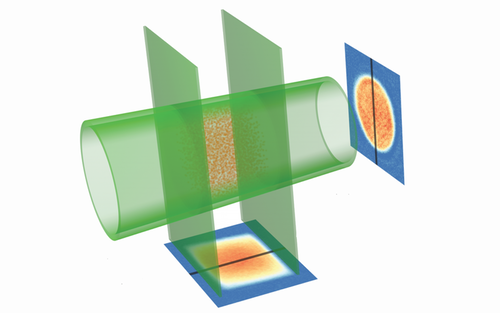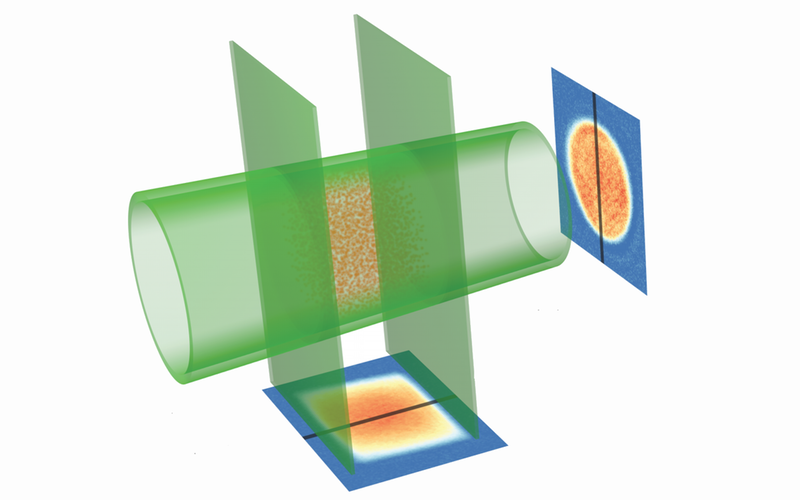Making Waves in a “Glass” Full of Atoms
Martin Zwierlein lifted his left hand and rounded his fingers and thumb as if to hold a glass of water. Using a finger on his other hand, he gently tapped on the outside of the imaginary container. Speaking to a crowd of cold-atom physicists at a workshop at the Harvard-Smithsonian Center for Astrophysics, Zwierlein, who is a physicist at the Massachusetts Institute of Technology (MIT), Cambridge, explained that taps create waves that ripple across the water’s surface and then slowly die out, in a manner that reveals the water’s properties. In a fun experiment, with a serious side, Zwierlein and his colleagues recently tried tapping a “glass” of extremely cold atoms, which can also behave like a liquid. At the workshop, he revealed their first results.
Monitoring the attenuation of waves traveling across a liquid surface is a standard way of determining the liquid’s viscosity and other properties. “When researchers discovered liquid helium, one of the first things they did was tap [it],” Zwierlein said, adding jokingly, “although not with their hands.”
But, until recently, performing the same experiments in cold atoms proved vexing because no appropriate “glass” to hold them existed. Traditionally, researchers trap clouds of ultracold atoms using crisscrossing laser beams focused on a single point in space. Atoms are polarized by these beams and pushed towards the beams’ focal point, where the light is most intense. The resulting cloud of trapped atoms is therefore denser in the center than elsewhere. This inhomogeneity complicates a tapping experiment because the wave motion depends more on the shape of the trap than on the properties of the fluid-like atoms.
Last year Zwierlein and his team developed a “laser box” that gets around this problem. The box, which resembles a closed tin can and is just a tenth of a millimeter long, lets the trapped atoms spread out evenly. A ring-shaped laser creates a hollow cylindrical light beam, providing sideways confinement for the atoms. And two laser “sheets” cap either end of the cylinder, stopping the box’s contents from spilling out. To tap the box, the team toggles the intensity of one of the capping lasers, sending ripples through the trapped atoms. They then use an atom-imaging technique to watch the ripples.
The group’s first experiments with the laser box were with lithium-6 atoms, which are fermions that interact strongly with one another. When chilled to close-to-absolute-zero temperatures, these atoms behave like a liquid, eventually forming a superfluid at around 50 billionths of one kelvin. The team cooled the lithium atom liquid to various temperatures, tapped on the laser box, and measured the speed and amplitude of the resulting waves. At all temperatures, they found that the waves decayed as expected for a classical fluid like water, with no discernable difference in the decay rate when the atoms transitioned to the superfluid phase. The finding is surprising, Zwierlein said. That’s because a superfluid is normally described as having zero viscosity, so a wave moving through it should decay more slowly than in a normal liquid.
The measurements also exposed two quintessential behaviors of quantum fluids: First, the team found that the diffusion of the waves is governed by Planck’s constant divided by the atomic mass, which has also been observed in superfluid helium-4. Second, in the superfluid regime, the team detected what’s known as a propagating temperature wave, or “second sound.” In a conventional liquid, heat diffuses away from a hot spot in a uniform way. But in a superfluid, heat moves outward in waves. “Only in a superfluid do temperature waves come alive and start to happily propagate,” Zwierlein said.
“The physics of these waves is just so beautiful,” Zwierlein said. Studying the waves might help physicists get a better handle on the viscosity and other properties of strongly interacting fermions, which are hard to predict theoretically because of the system’s complex quantum behavior. The experiments also have a personal significance for Zwierlein. He says that 70 years ago, physicists at MIT tapped on liquid helium “in the very same research lab where we do our experiments now.”
–Katherine Wright
Katherine Wright is a Senior Editor for Physics.





